

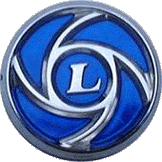
 |
 |
|||||||
© 2024 |
Triumph Stag PartsThis page covers general information about buying parts. After reading this page, you may also wish to look in the Classifieds in the Members Only section to see whether a TSC member is selling the part you seek.
Parts Quality and Customer Service, by Glenn MerrellAn important note on parts quality and customer service In My Not So Humble Opinion, long winded ... : Your Triumph demands the best parts quality that you can afford. OEM parts or better. The reason for this is safety, safety to you, safety to others. TSC USA recommends that you buy only from reputable suppliers who stand behind their parts quality not only with written word warranty and written customer service policy, but suppliers who actually perform to the standards they write through their action and high percentage of satisfied customers. If you have a problem with parts quality and / or customer service from any supplier, the TSC USA wants to hear about it. And, if you have a story to tell of exemplary quality and customer service from a supplier, demonstrating that the supplier went the "extra mile" to make your Triumph ownership and buying experience just that bit higher level of standard, the TSC USA wants to particularly recommend those suppliers to enthusiasts. Please let us know your experiences, good and bad, complete with details. I must also state, like my daddy told me, and IMNSHO, that you don't get something for nothing. To this of course, I am referring to "free shipping" or "free carriage" offers. Shipping always costs someone and one way or the other, it is always the recipient. Rarely is such a huge volume purchased of a classic car quality part that could warrant it to be sold at its normal price and deliver it free of charge. If that is the case it is usually openly advertised as such. Since this "free" cost must be borne by the supplier, the cost must come out somewhere else and that is in the original purchase cost of the goods being sold. If the purchase cost does not reflect the shipping cost difference for free delivery, then its per item cost itself must somehow be lowered, and that is done either by huge numbers in ordering, or by sacrificing quality of materials, labor and manufacture to purchase the parts at a lower cost. Those are given facts in supply chain management, and any of you whose business involves supply know this to be a fact. OEM or Original Equipment Manufacturer parts made to original or better specification. Often you will see a part as "uprated". Uprated is not always better. Make sure you ask if the parts you are receiving are OEM or better, and even more, ask for the name of the manufacturer. You do not know unless you ASK, and in some cases you may be getting a cheap knock off part that is identified as uprated. Be informed, ask the questions. If enough owners begin demanding quality OEM parts, the suppliers will get them made. The key to getting the best rates is to consolidate your orders to reduce repetitive shipping and keep orders below customs values that trigger a tariff or duty, usually $400 USD for US customs. Allow the supplier to consolidate parts that may be temporarily out of stock, but be sure to inquire as to how long the delay will be. Heavy weight metal objects such as engines, transmissions and differentials usually can be rebuilt for less cost than what it would cost in shipping from overseas to the US, unless coordinated with an other bulk shipping of parts going to a US supplier. But if you want those types of parts from a supplier, again, expect to pay the shipping costs as you would not like to sacrifice the dollar amount of work that should be going into those critical components assembly. The old adage rings true, you get what you pay for, usually. Caveat Emptor, ya'll. What to do if you receive the incorrect part?
FIRST, verify it is indeed incorrect, and that you did not place an incorrect order. If you are then verified, contact the supplier immediately and explain the problem. The supplier will, if reputable, replace the part at no charge to you. Also, if the part needs to be returned to supplier, the supplier should also collect the part at their cost if the mistake was theirs. The suppliers are listed alphabetically for your reference only. The TSC USA makes no endorsement of their quality or service unless it is noted next to the supplier. There are quite a few Triumph and British Car parts suppliers in the USA. Many parts on the Stag are shared with other Triumphs and British Cars. If you find a supplier who stocks parts for your Stag, please supply us with the details so we can include them on this list. Glenn Merrell
KYB Gas Shocks and Struts for the Stag, by Wayne SimpsonKYB Gas Shocks are available in the US. Struts are not. KYB Gas rear shocks are indeed available here. They cross over the the Triumph TR7/TR8 and can be ordered from any number of sources. The KYB Part number is KG5550. Front Strut cartriges are another matter. They are unique to the Stag and 2000 series and are not listed in the KYB US catalog. You have to go to Kayaba Europe for them. Part number is 365048. Kayaba Europe can be found on the web at www.kayabaeurope.com Look under "Austin Rover" for Triumph applications. Paddocks stocks the struts or they can be ordered from several UK distributors. In summary: Front: 365048 available from Kayaba Europe Wayne Simpson, Editor, Stag News
Stag Radiator Cowl Sets, by Glenn MerrellCowl Sets in Thermoformed Polycarbonate Plastic Now Available The Triumph Stag Radiator Cowl Set, P/N 312298C and 312299C, Originally stamped from 0.060 inch mild Steel sheet was supplied only to Federal Specification and Australian Stags sometime during 1972 and forward. There were probably less than 3000 original metal cowl sets made with most being removed when the fan hit the cowl from sagging motor mounts, making noise. The first remake of this cowl set was of Composite polyester and fiberglass polyester resin from a mold made from an original metal cowl. This was due to the reproduction costs for a Metal stamping and tooling were far too high for a small batch run to reproduce the OE metal part even in China. Now the third generation of this cowl set is here. It is made in the USA of 0.09625 inch Aircraft Quality Polycarbonate, thermoformed, trimmed and drilled into the same size of the old original stamped metal cowl. I have fitted the upper (312298C) and lower (312299C) pieces (Triumph Stag Parts Catalogue 05-06) to both a Mark II radiator (PN 403049), and a Mark I radiator (PN 402808). Mark I radiators require some modification to the top and bottom core positioning metal to add some through holes by drilling, and some overflow line re-routing. These cowls should also fit PN 403008 / PKC230 radiators, which show having the holes for the spire clips in the (from in the Triumph Stag Parts Catalogue) corners of the radiator. However, the pictures here show the Stag 16.5" metal fan, PN 218666 as opposed to the 16.5" plastic fans PN 312302 or 313356 (Triumph Stag Parts Catalogue sections 02-25, 26, 27) that use different Torquatrols. The pictures of the New ABS Cowl compared to an original metal cowl set show how close they are in fit, form and function. Watch for the Deflector Shield, PN 313090 to be added to this set as an option soon! UPDATE: Mold fabrication is in process 4-16-2007! NOTE: Price is as delivered IN the USA. Shipping costs are extra outside the USA and overseas. Contact and Questions: Price: $230 Delivered to USA addresses. Overseas addresses shipping is EXTRA which will include required Insurance and Delivery Confirmation. Typical 5-7 day Express Mail day shipping to the UK & Australia complete is about $38 USD. Glenn Merrell
Give Me a Brake: Key points about the brakes of your Triumph StagIf your car won’t go, it’s an inconvenience. If it won’t stop, it’s a catastrophe in the making. All things considered, your brakes are the most important system on your car, so it makes sense to keep them in top working order. When a car sits for a long time, it’s not uncommon for the brakes to freeze up and no longer work properly. This is because the hydraulic brake fluid will absorb moisture from the air even if the car isn’t being driven. Over time, the fluid will take on so much water it will precipitate out and collect in the low points, oil being lighter than water. Those low points are typically the rear wheel cylinders and, to a somewhat lesser extent, the front calipers. Water that collects in the rear wheel cylinders, even in very small amounts, will cause rust in the bores and this freezes the pistons tight. In the case of the Stag, the cylinders are angled back, so the rear piston is normally the first to rust solid. People who say that Triumph brakes don’t work are typically running around with stuck rear wheel cylinders, and no braking at all in the back end. Brake Fluid Color in Master Cylinder
So what goes into a brake job? I recently did a complete front and rear brake service on a car with brakes like those I just described; no braking at all coming from the rear. I won’t go through a step by step procedure since you should have a Repair Operations Manual (ROM) to tell you that. Follow the instruction carefully and you should do a good job. Here’s some of what I did and learned. Stag Rear Brakes Have a look at the wheel cylinders. Is either piston stuck? Do you see any evidence of leakage? If the answer to either question is yes, you either have to rebuild or replace the cylinders. At a cost of about $20 each, I typically find myself replacing wheel cylinders unless I have a rebuilt pair ready to go on. If you like to be self sufficient, buy a reseal kit and a brake cylinder hone and rebuild the old cylinders (if you can get them apart) at your leisure for future use. Replace wheel cylinders in pairs. If one is bad, the other soon will be. Have a good look at the flexible brake hoses. Are there any cracks or bulges in the rubber? Are they simply old? If the flexible brake lines are more than 10 years old, they can swell internally and block the passage of the brake fluid. With internally swollen hoses, you will typically be able to apply the brakes, but they won’t release. This is because while the brakes are applied under great pressure, there is relatively little pressure available to release them and so they drag. Which hoses to buy? The stainless braided hoses are pretty and resist swelling under pressure better than rubber hoses, but they cost quite a bit more. New rubber hoses are perfectly adequate, and they’re certainly better than 30 year old swollen, cracked ones. You have two flex hoses at the front, and two at the rear. Some people will tell you there’s no need to have the drums turned when you install new shoes. Well, at the risk of offending those people, they’re wrong. They’re just wrong, plain and simple. Your brakes will work best with a freshly machined surface free of grooves and glaze. If the drums are too thin to be resurfaced (the minimum thickness is stamped onto the drum) replace them. Moving to the front, most of the same rules apply. If either of the caliper pistons is stuck, you’ll need to rebuild them. Calipers are a lot more expensive than the wheel cylinders on drum brakes, so you will normally reseal them or send them out for rebuilding. Once the calipers are off the car, remove the pistons by holding one and pressurizing the caliper with a bicycle pump. Be careful, the pistons can come out with a lot of force so watch your fingers. Stag Front Brake
If the bores are in bad shape, you will need to have them honed or, in extreme cases, sleeved. But if there is little or no rust and the pistons are in good shape you can go ahead and put new seals in. This is easiest to do with the calipers split apart, so get seal kits that include the bridge seals. Make sure the seal grooves are clean, and use brake caliper lube to coat the new seals as you put them in. Once the seals are in, insert the piston. You will need a “distancing tool” to press home the retaining ring for the wiper seal. There is an official tool for this but I have no idea where to get one, so I use a short length of pipe or tubing (aluminum or even PVC) slightly larger in inside diameter than the outside diameter of the piston. Use a large “C” clamp or a bench vise to press the retainers home. Once both are done, install the new bridge seal and reassemble the caliper. The same rules from the rear brakes regarding flex hoses and resurfacing apply to the front. Have the rotors resurfaced or replace them if they’re too thin. Thin rotors are less resistant to warping. If you replaced the flex hoses on the rear, replace them in the front as well. Buy a new fitting kit for the pads, consisting of the two anti-rattle spring clips and the two very long cotter pins per side. Fit new anti-squeal shims, too. They are asymmetric just like the brake pads, and only go on one way. Don’t forget to clean out the old grease in the hubs and repack them half full with new grease. Clean and repack the wheel bearings, and replace them if they or the bearing races show signs of wear. Don’t forget to order new grease seals for the hubs. When you tighten the hub bearings, be careful not to over tighten them. Use a torque wrench to set to specs, then back off only enough to insert the cotter pin in the first available slot in the castellated nut. Also don’t forget to clean and repack the grease caps with new grease, leaving the hole in the center clear. Now it’s time to bleed the brakes. The classic method is to have a helper press down on the brake pedal while you open, bleed, and close the bleeder screw. New devices such as vacuum or pressure bleeders, this is reduced to a one man job. If you use one of these gadgets, especially a pressure bleeder like the Gunson “E-Z Bleed”, be very careful to make sure they’re sealed before you apply the pressure, and use the minimum pressure necessary to do the job. I don’t call mine the “E-Z Leak” for nothing. Always bleed from the cylinder farthest from the master cylinder to the nearest. On a Federal LHD Stag, that would be right rear, left rear, right front, left front. Bleed the brakes until you see clean, clear brake fluid coming through the hose and there are no bubbles at all. You will use upwards of three pints of fluid to flush out and bleed a brake system completely. Use only Castrol LMA (Low Moisture Activity) brake fluid or convert to the new silicone fluids. Never use plain old DOT3 fluid, as these will cause damage to the natural rubber brake seals in classic British cars. Completed Stag Rear Brake
Once you’ve done all this, how do you keep the brake system in top shape? First, you use the car regularly. Second, you flush and bleed the hydraulic system at regular intervals so it never takes on enough moisture to cause rust again. How often is that? If you live in a really humid climate such as the Gulf Coast, flushing the brake system every year or two might be advised. For most other places, every three years should do nicely. In very dry environments, the interval might be extended to every four or five years. Once your brakes are in top shape, just a little maintenance every few years will keep them working up to their potential.
Copyright © by Triumph Stag Club USA All Right Reserved.
|
4/26/2024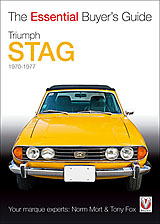   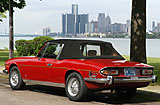 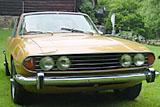 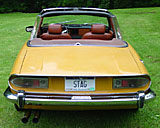 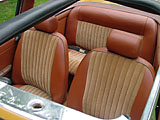 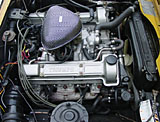 | ||||||